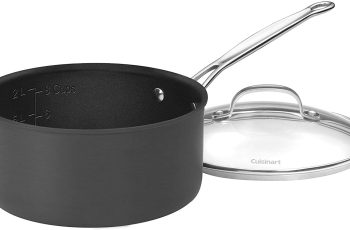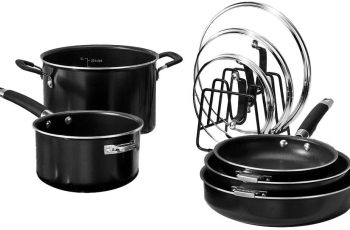Ad Blocker Detected
Our website is made possible by displaying online advertisements to our visitors. Please consider supporting us by disabling your ad blocker.
In this informative article, you will discover essential tips and techniques for maintaining the cleanliness and longevity of your saucepan. From removing burnt-on food to preventing stubborn stains, we will guide you through the process of effectively cleaning and caring for your saucepan. By following these simple yet effective steps, you can ensure that your saucepan remains in pristine condition, allowing you to continue creating mouthwatering dishes with ease.
Importance of Cleaning and Care
Maintaining hygiene and prolonging the lifespan of your saucepan are two essential reasons why cleaning and care are important. Neglecting to clean your saucepan regularly can lead to the buildup of bacteria and food residue, compromising the safety and quality of your cooking. Additionally, proper cleaning and care can help preserve the integrity of the saucepan, preventing damage and ensuring its longevity.
Materials and Tools
Before diving into the cleaning and care process, it is important to gather the necessary materials and tools. Here are some items you will need:
- Sponge or soft cloth: Used for general cleaning and wiping.
- Mild dish soap or detergent: Ideal for removing grease and stains.
- Non-abrasive scrub brush: Helps to remove stubborn residue without scratching the surface of the saucepan.
- Vinegar or lemon juice: Effective for removing lime deposits and discoloration.
- Baking soda: Works as a natural abrasive cleaner.
- Soft-bristle brush or toothbrush: Useful for cleaning hard-to-reach areas.
- Paper towels: Perfect for drying the saucepan after cleaning.
- Cooking oil or spray: Essential for seasoning and maintaining the saucepan.
General Cleaning
Cleaning after each use
To ensure the longevity of your saucepan, it is vital to clean it after each use. Start by allowing the saucepan to cool down before cleaning. Then, using a sponge or soft cloth, gently wipe the interior and exterior to remove any food residue or grease. If there are stubborn stains or burnt-on food particles, proceed to the next section.
Removing food residue
Sometimes, you may encounter stubborn food residue that won’t come off with just a gentle wipe. In this case, fill the saucepan with warm water and add a few drops of mild dish soap or detergent. Let it soak for a few minutes, then use a non-abrasive scrub brush to gently scrub away the food residue. Rinse thoroughly with water and dry with a paper towel.
Removing burnt-on stains
Burnt-on stains can be particularly challenging to remove from a saucepan. To tackle this issue, fill the saucepan with a mixture of equal parts water and white vinegar. Bring the solution to a boil and let it simmer for about 10 minutes. Once the stains have loosened, carefully scrub the saucepan with a non-abrasive scrub brush. Rinse thoroughly and dry.
Deglazing the saucepan
Deglazing the saucepan after cooking certain dishes can help remove any cooked-on residue and flavors. To deglaze, pour a small amount of liquid, such as broth or wine, into the saucepan while it is still hot. Using a wooden spoon or spatula, gently scrape the bottom of the pan to release the flavorful residue. Discard the liquid and wash the saucepan as usual.
Deep Cleaning
Removing stubborn stains
If you encounter stubborn stains that are resistant to general cleaning methods, a mixture of baking soda and water can work wonders. Create a paste by combining baking soda and water until it forms a thick consistency. Apply the paste to the stained areas and let it sit for a few minutes. Then, use a soft-bristle brush or toothbrush to scrub away the stains. Rinse thoroughly and dry.
Removing discoloration
Over time, saucepans can develop discoloration, particularly on the exterior. To restore the shine and color, create a paste using equal parts vinegar or lemon juice and baking soda. Apply the paste to the discolored areas and gently scrub with a non-abrasive scrub brush. Rinse thoroughly and dry.
Removing lime deposits
Lime deposits can accumulate on the saucepan due to the minerals present in water. To remove these deposits, fill the saucepan with equal parts water and vinegar. Bring the solution to a boil and simmer for about 10 minutes. Afterward, use a non-abrasive scrub brush to scrub away the lime deposits. Rinse thoroughly and dry.
Removing rust
If you notice rust spots on your saucepan, it is crucial to address them promptly to prevent further damage. Create a paste using baking soda and water, then apply it to the rusted areas. Let it sit for a few minutes, then use a soft-bristle brush or toothbrush to scrub away the rust. Rinse thoroughly and dry. For severely rusted saucepans, it is recommended to consult a professional for restoration.
Care and Maintenance
Avoiding metal utensils
Using metal utensils while cooking in your saucepan can cause scratches and damage to the surface. To maintain the saucepan’s integrity, opt for non-metal utensils like wooden or silicone spatulas and spoons. These utensils are gentler on the saucepan and will help prolong its lifespan.
Avoiding extreme temperature changes
Rapid temperature changes can lead to warping or cracking of the saucepan. Avoid placing a hot saucepan directly under cold water or transferring it from extreme heat to extreme cold. Allow the saucepan to cool down naturally or use a trivet or pot holder to protect surfaces when placing the hot pan on them.
Proper storage
Properly storing your saucepan is essential for maintaining its condition and preventing damage. Ensure the saucepan is completely dry before storing it to avoid the growth of bacteria and mold. If the saucepan has a removable handle or lid, store them separately to prevent any potential scratching or damage.
Seasoning the saucepan
Seasoning your saucepan is not only a method for improving its non-stick properties but also helps to maintain and protect its surface. After cleaning the saucepan, lightly coat the interior with a thin layer of cooking oil or spray. Heat the saucepan on low heat for a few minutes, then wipe away any excess oil with a paper towel. This process should be repeated periodically to keep the saucepan in optimal condition.
Cleaning Different Saucepan Materials
Cleaning stainless steel saucepans
Cleaning stainless steel saucepans can be relatively straightforward. Use mild dish soap or detergent and warm water with a sponge or soft cloth to clean both the interior and exterior. For stubborn stains or burnt-on food, utilize the techniques mentioned earlier, such as deglazing with vinegar or lemon juice.
Cleaning non-stick saucepans
Non-stick saucepans require extra care to preserve their non-stick coating. Use a gentle, non-abrasive sponge or soft cloth to clean both the interior and exterior. Avoid harsh chemicals and abrasive tools that can damage the non-stick coating. It is recommended to refer to the manufacturer’s instructions for specific cleaning guidelines.
Cleaning copper saucepans
Copper saucepans require special care to maintain their lustrous appearance. Clean the interior and exterior with a mixture of equal parts vinegar or lemon juice and salt. Gently scrub the surface with a soft-bristle brush or cloth. Rinse thoroughly and dry with a paper towel to prevent water spots or tarnishing.
Additional Tips
Don’t use harsh chemicals
Harsh chemicals, such as bleach or strong detergents, can damage the saucepan’s surface and potentially leach harmful substances into your food. Stick to mild dish soap or detergent, vinegar, lemon juice, and baking soda for effective and safe cleaning.
Avoid abrasive cleaning tools
Abrasive cleaning tools, like steel wool or abrasive sponges, can scratch and damage the saucepan’s surface. Opt for non-abrasive scrub brushes or soft cloths to ensure the longevity of your saucepan.
Regularly inspect the saucepan
Periodically inspect your saucepan for any signs of damage, such as warping, loose handles, or worn-out non-stick coating. Promptly address any issues to prevent further damage and potential safety hazards.
Follow manufacturer’s instructions
Each saucepan may have specific cleaning and care instructions provided by the manufacturer. Refer to these instructions for the best cleaning methods, as they are tailored to the specific materials and coatings of your saucepan.
Troubleshooting
Stuck-on food that won’t come off
For stubborn stuck-on food, soak the saucepan in a mixture of warm water and mild dish soap or detergent for an extended period. This will help loosen the residue, making it easier to remove. If necessary, use a non-abrasive scrub brush to gently scrub away the food particles. Rinse thoroughly and dry.
Persistent discoloration or stains
If you are having trouble removing persistent discoloration or stains, consider using specialized stainless steel or copper cleaners. Be sure to follow the manufacturer’s instructions and test the cleaner on a small, inconspicuous area of the saucepan before applying it to the entire surface.
Rusty spots on the saucepan
To address rusty spots on your saucepan, apply a mixture of vinegar or lemon juice and salt to the affected areas. Let it sit for a few minutes, then use a soft-bristle brush or toothbrush to scrub away the rust. Rinse thoroughly and dry. For severe rust, consult a professional for guidance.
Damage or warping of the saucepan
If your saucepan has suffered significant damage or warping, it may be time to consider replacing it. Using a damaged saucepan can compromise its safety and performance, making it less effective for cooking.
Conclusion
Ensuring the cleanliness and proper care of your saucepan is crucial for a better cooking experience. By following the recommended cleaning techniques and maintenance tips, you can maintain the hygiene of your saucepan, prolong its lifespan, and enjoy many delicious meals with confidence. Take the time to care for your saucepan, as it will reward you with longevity and enhanced culinary results.

